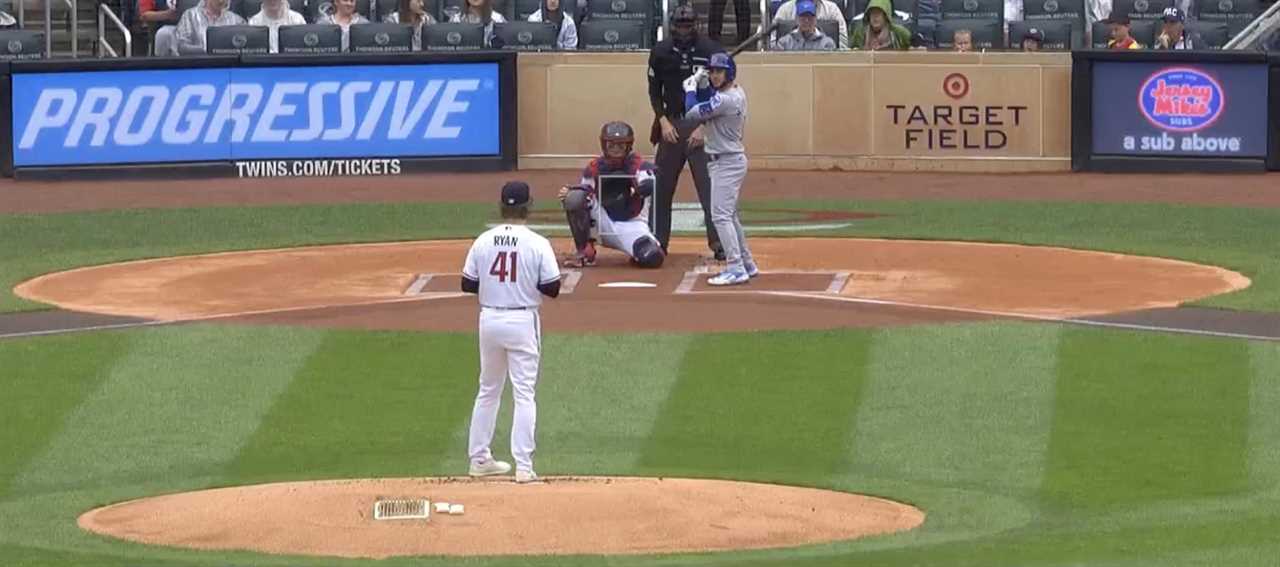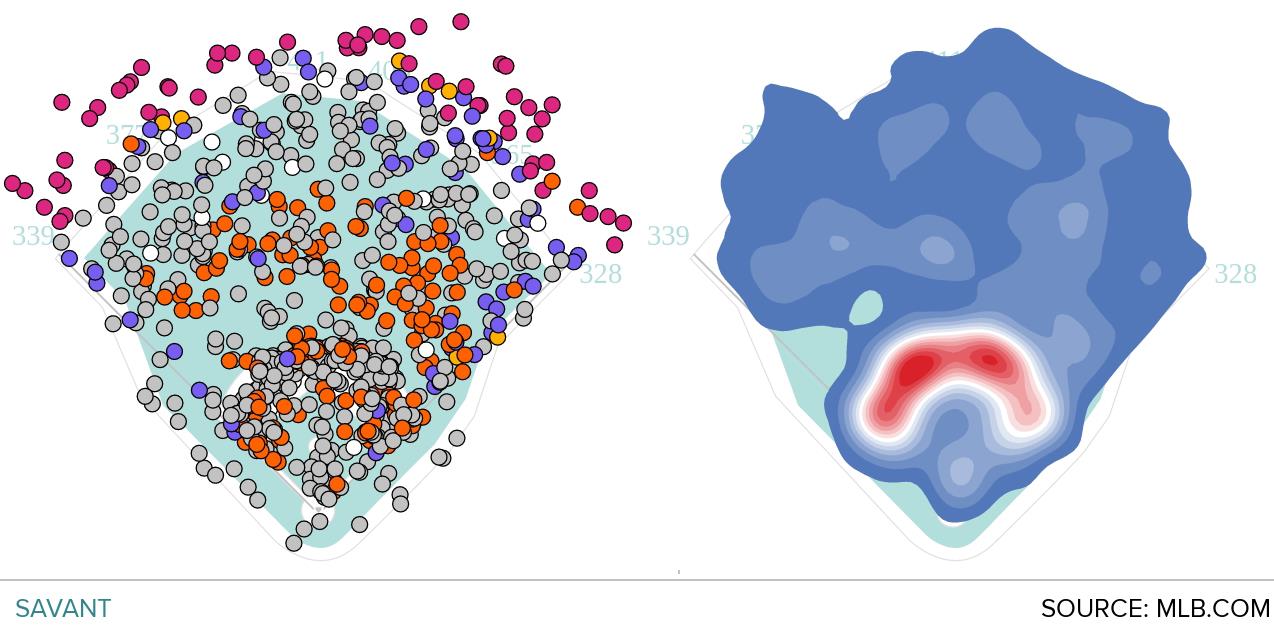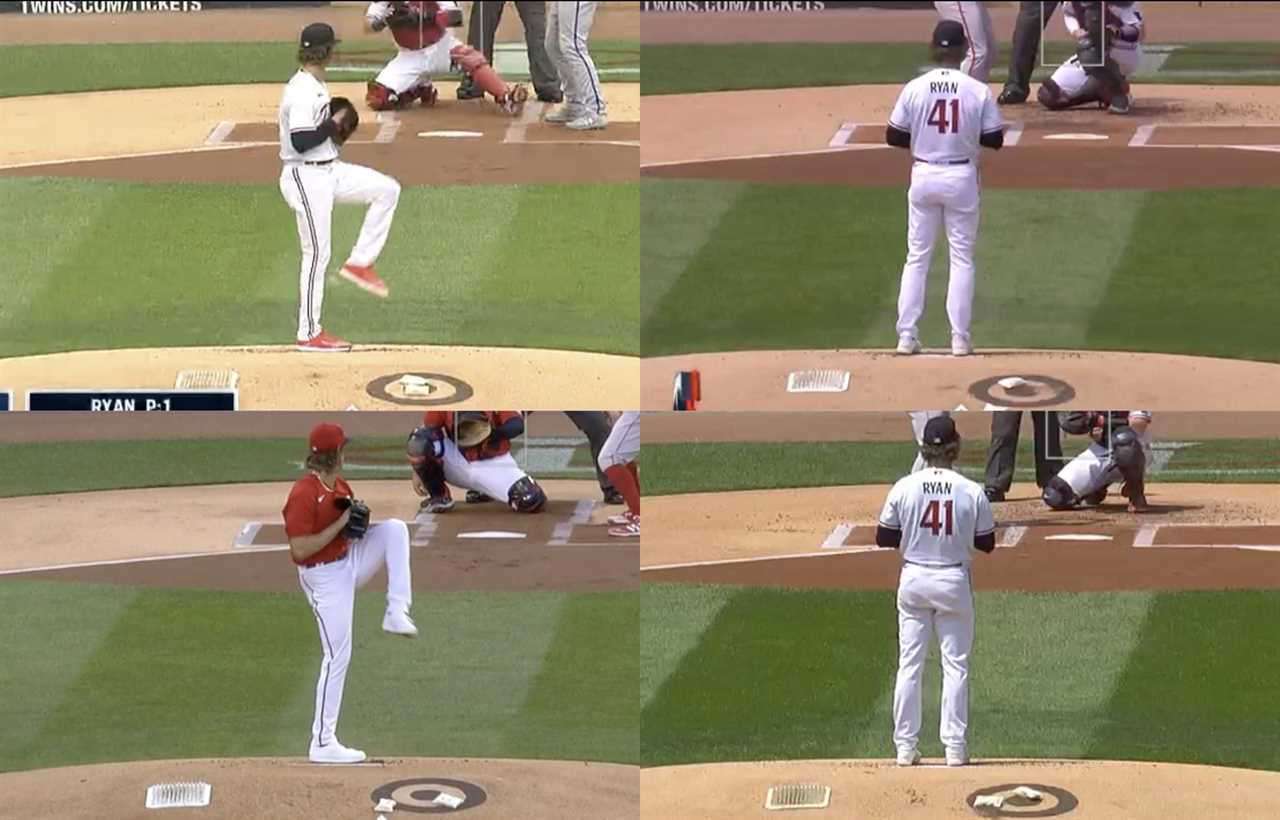When Carl Pavano threw the first official pitch at the brand new Target Field on April 12, 2010, there was no Target logo on the mound. Mind you, there were Target logos aplenty all around the ballpark — on the wall behind home plate, just below the press box, up above the bleachers in right and center field, on the signs the fans brought and the hats they wore, and on the video boards on the façade of the upper deck, which often displayed rows of alternating baseballs and Target logos, hundreds of them wrapping around the entire stadium — just not on the pitcher’s mound. Later that year, the interlocking T and C of the Twins logo began appearing in the dirt behind the rubber; the Target logo didn’t start gracing the mound until 2016.
Still, in the early years of 2016 and 2017, the mound was often completely targetless. Even today, there are games where there’s no logo whatsoever — and not just nationally televised games, when the advertising rights can change. Sometimes it’s just the pitcher all alone up there (aside from the rubber, the cleat cleaner, and a couple rosin bags):

I don’t have any good guesses that explain the logo’s occasional absence, but I have so, so many bad guesses. Maybe the grounds crew is hiding the target somewhere else on the field and we’re supposed to be looking for it. Maybe Target leases the space on a per-game basis, and sometimes whoever is in charge of delivering that day’s check gets lost during the half-mile walk from Target Plaza Commons headquarters to Target Field. Maybe — and hear me out on this one — maybe the grounds crew just gets busy sometimes. I don’t know why it’s not always there, but if it’s supposed to be there every game, I hope this paragraph doesn’t get anybody in trouble.
Although things are much more consistent today, the logo still moves around quite a bit, and even changes color. It’s usually located behind the rubber and off to the third base side, painted a deep, German chocolate brown. But the color has sometimes been lighter, especially during the 2020 season, and the location varies both in longitude and latitude. Occasionally, the logo even shows up on the first base side of the mound:

For a long time now, I have been watching Twins games and asking myself two questions: Has anybody ever hit the target? And is anybody even thinking about hitting the target? After all, that’s what targets are for. Think of all those HIT IT HERE signs that fans bring to the ballpark. Think of all those promotions where somebody wins a prize if the batter hits the ball to a certain spot. The Twins literally have a target located on the most prominent spot on the field. It beggars belief that nobody’s keeping track of whether or not someone actually hits the bullseye, and yet here we are. It’s time to rectify this situation. It’s time for an investigation.
Let’s start with a thought exercise. Say we dropped a ball from an airplane and it landed on a completely a random spot on Target Field. How likely would that ball be to hit the logo? I estimate that the logo is 26 inches, giving it an area of 3.687 feet. Next, I took Baseball Savant’s diagram of Target Field and used Photoshop to measure the total area of fair territory at 117,739.6 feet. By these estimates, the ball we dropped from the airplane would have a 0.003% chance of hitting the logo, or 1-in-31,934. That’s convenient, because between the regular season and the playoffs, there have been 31,509 balls put in play at Target Field since 2016. If batted ball distribution were completely random, we would only expect one ball — well, technically 0.99 balls — to have hit the Target logo over the past eight seasons.
However, batted ball distribution isn’t random. The ball gets hit to some spots more than others. That’s why the fielders carry those little positioning cards in all their nooks and crannies. Below is a spray chart and a heat map of all the batted balls the Twins hit at home over the second half of the 2023 season (the biggest sample I could use without breaking Baseball Savant):

The back of the mound isn’t completely devoid of baseballs, but it’s by no means a hot spot. Of the 31,509 balls in play at Target Field since 2016, Statcast lists just 158 as hit straightaway with an estimated distance between 61 and 70 feet. That’s 0.5% of all batted balls, and we’re talking about an area at least 100 times bigger than the area of the logo itself (depending on Statcast’s definition of straightaway). If anything, it seems less likely that a batted ball would be headed for that exact spot than one placed on the field randomly, and that’s before we factor in the slope of the mound.
That’s right, the mound is sloped. Have you ever stopped to consider just how weird it is that the mound exists at all? There’s this tiny little mountain in the middle of the field! No other team sport has a playing surface pocked with geological features, though I would love to see a hockey game at a rink with a big ice ramp so the players could do cool jumps in the middle of a breakaway.
The logo is located on the Eastern slope of Mount Target, meaning that there’s no line of sight from the batter’s box. If you were waging war on the batter, that’s exactly where you’d dig in, because it has great cover. It’s the only spot on the field that has defilade from home plate. Unless you’re a mortar man, that makes the physics of actually hitting it extremely tricky. A ball hit directly at the logo would hit the top of the mound and then bounce away:
In order to actually hit the logo, the ball needs to be hit hard enough to pass over the plateau at the top of the mound, but soft enough that gravity has time to pull it down to hit the downslope, which is much steeper than the slope on the front of the mound. That gives us a range of launch angles and exit velocities to play with, from a high popup to a weakly hit line drive:
Let’s start with weakly hit line drives, which have two complications. The first is that line drives are the balls least likely to be hit weakly, especially when they’re hit back up the middle. In 2023, the average line drive was hit 94 mph, compared to 92.1 for fly balls, 85.1 for popups, and 85 for groundballs. And balls that are very weakly hit often come on jam shots and cue shots, when the batter is either way behind or in front of a pitch. When you’re way in front or way behind, your bat is at a fairly extreme angle, making it less likely that you’ll direct the ball straight toward second base.
The second complication is much more important: There’s a pitcher standing right there. He’s got a glove and everything. Maybe you could hit a rocket right back up the middle past the pitcher, but a rocket would also zip right past the logo because its trajectory wouldn’t dip enough after it made it past the top of the mound. That’s why we’re looking for weakly hit line drives, and weakly hit line drives generally get caught because, again, there’s a pitcher standing right there:
That leaves us with popups. Let’s say that after he releases the pitch, our friend Pablo López needs a moment to regain his balance and doesn’t have time to backpedal and field the ball. Or maybe he decides to obey the arcane baseball law that says no pitcher may ever attempt to catch a pop fly, lest he stumble off the mound and fall directly onto his pitching shoulder, rendering his arm unusable for the rest of his life. Even if that happens, the pitcher’s not the only person on the field. If the ball’s hit high enough to get past him, that means that it’s most likely hit high enough that there’s time for one of his work proximity associates to swoop in and make the play:
All of this is to say that it’s really dang hard to hit the ball at that one exact spot. It might even be the hardest spot on the entire field. It sits at an awkward position in the matrix of launch angle, spray angle, and exit velocity. And even if you do manage that 1-in-32,000 feat, you’re almost certainly going to be foiled by the slope of the mound, or by one of those meddling fielders, who apparently have nothing better to do than run around and catch the baseball. But you know what? Maybe somebody pulled it off anyway. That’s why they play the games. I watched every one of those 158 batted balls hit straightaway at a distance of between 61 and 70 feet, and then I watched a whole lot more.
First came the balls that were hit at a trajectory that might have sent them right at the logo. We’ll never know for sure whether they would have hit it, because they hit the top of the mound instead and skipped on by. One benefit to watching these plays one after another is that the pitchers prove to be highly entertaining. The low liners kick up a little plume of dust at their feet, and they jump every which way, sometimes in order to catch the ball and sometimes in order to get the hell out of the way. It’s a lot like watching a cowboy movie where the bad guy says, “Now dance!” and starts shooting at the good guy’s feet:
Next came the soft line drives. In fact, I looked at hard-hit line drives too, watching every liner with an estimated distance up to 100 feet. My thinking was that although those balls might have been hit too hard to land directly on the logo, they could have caught the pitcher by surprise and taken a fortunate bounce off a glove or a body part. But again, no luck. As it turns out, pitchers are shockingly good at either catching the ball or finding other, more painful ways to keep it in front of them. However, for four years, Minnesota was home to Luis Arraez, the world’s foremost purveyor of line drives hit just hard enough to be useful. If not for Shane Baz making a catch that he did not seem at all certain about, Arraez really might have taken home the prize:
Last came the popups. Surprisingly, there were only three that would have landed within several feet of the logo. It really is extremely uncommon to see a popup land right at the back of the mound. However, the three that did end up in the neighborhood were very tantalizing. The closest of them came off the bat of Salvador Perez. If not for impressive concentration by Donovan Solano, who snagged the ball while simultaneously absorbing a cut block from first baseman Alex Kirilloff, the ball would have landed within a yard of the logo. So close, and yet Solano:
Unfortunately, that’s it. Our investigation has come to a close, and I can definitively state that no one has ever hit the Target target. But I still have hope. I know I just told you that nobody has ever done this thing over the course of eight years and nearly 32,000 balls in play, but it’s not impossible. A popup hit directly behind the pitching rubber constitutes real trouble, and it could easily cause enough confusion to fall in, as it almost did for Salvador Perez. And while it’s extremely hard to hit a line drive that lands on the back of the mound, it’s not impossible. The slow-motion clips below show Kelvin Gutiérrez and Shohei Ohtani doing just that. They also show Ramón Laureano and Jonathan Schoop hitting soft liners that were deflected by the pitcher and landed just behind the rubber. These are all methods by which some batter could one day strike true.
And that’s not the only hope I bring you. At the beginning of this article, I posed two questions. The first was whether anyone has ever hit the target, which proved to have a disappointing answer. The second was whether anyone is even thinking about hitting the target. That answer is much more fun. After watching and rewatching an ungodly number of popups and line drives, I can report that one person definitely seems to be thinking about hitting the target, and that’s Minnesota right-hander Joe Ryan:

Before Ryan starts an inning, especially the first inning, he usually tosses at least one rosin bag toward the bullseye. I can’t prove this next part, but I don’t think he’s just placing them there. I think he’s actively playing baseball cornhole. It happens too often to be a coincidence, and even when he misses, you can often see the marks from where the rosin bag skidded across the dirt:

Again, I can’t prove that Joe Ryan is doing this intentionally — yet. But you can rest assured that I’ll be watching for it this season. I watched the first pitch of several games that he started in 2023, as well as the beginnings of several later innings. Though the camera usually shows a few warmup pitches, it never sticks around to show the pitcher applying rosin and discarding the rosin bag. But if you scroll all the way up to the first picture in this article, you’ll see Joe Ryan standing on a mound with no logo on it. The rosin bags are sitting in a tidy row beside the cleat cleaner. With no target to launch them at, he didn’t seem to see the point in using them at all.
Someday, someone is going to hit the Target Field target with a batted ball. When that day comes, we will rejoice and I will write something silly. In the meantime, we’ll just have to keep an eye on Joe Ryan’s aim.
Source
https://blogs.fangraphs.com/has-anyone-ever-hit-the-target-field-target/
 Backyard GrillingWeekend WarriorsAdvice from DadBeard GroomingTV Shows for Guys4x4 Off-Road CarsMens FashionSports NewsAncient Archeology World NewsPrivacy PolicyTerms And Conditions
Backyard GrillingWeekend WarriorsAdvice from DadBeard GroomingTV Shows for Guys4x4 Off-Road CarsMens FashionSports NewsAncient Archeology World NewsPrivacy PolicyTerms And Conditions
